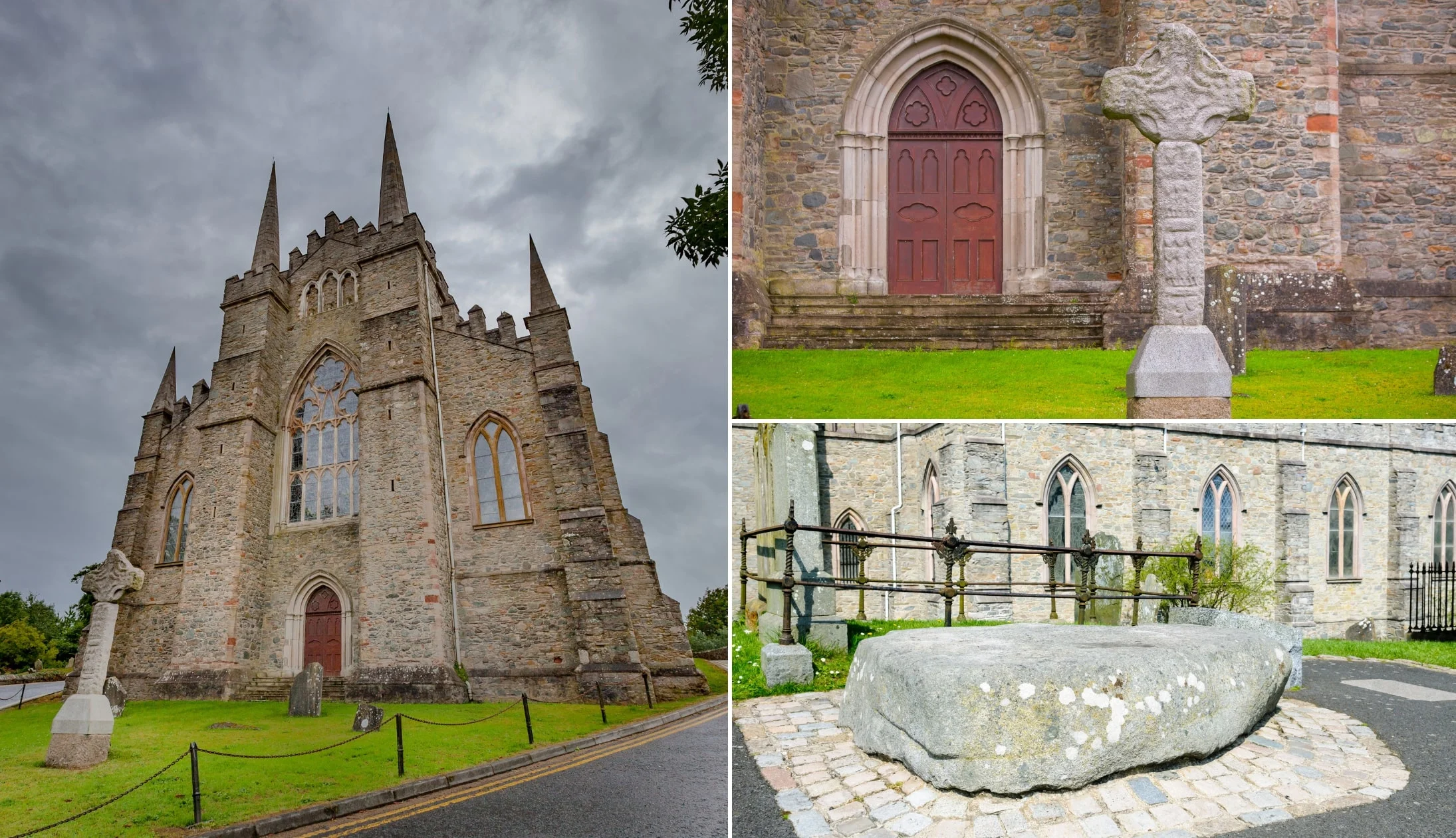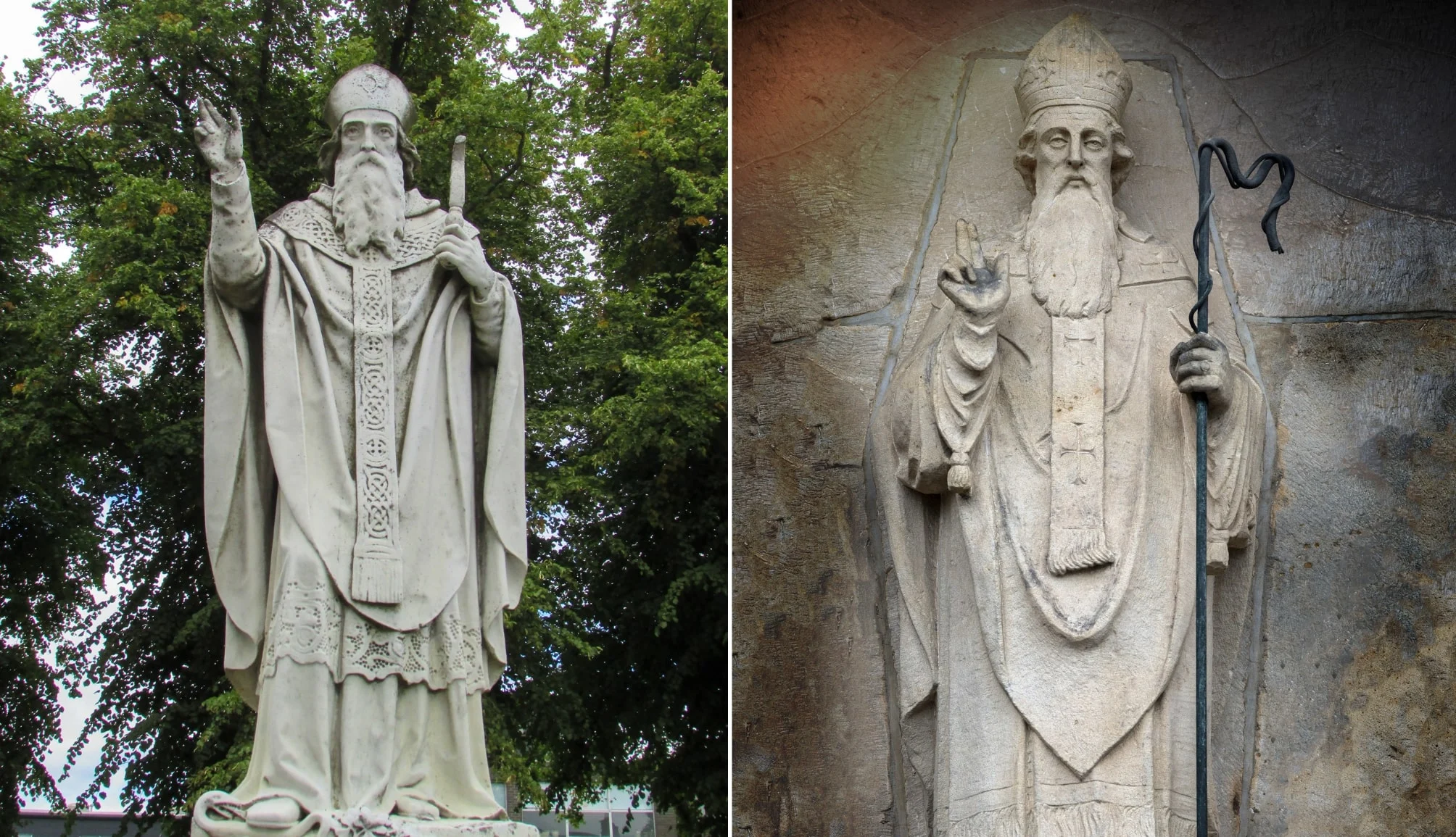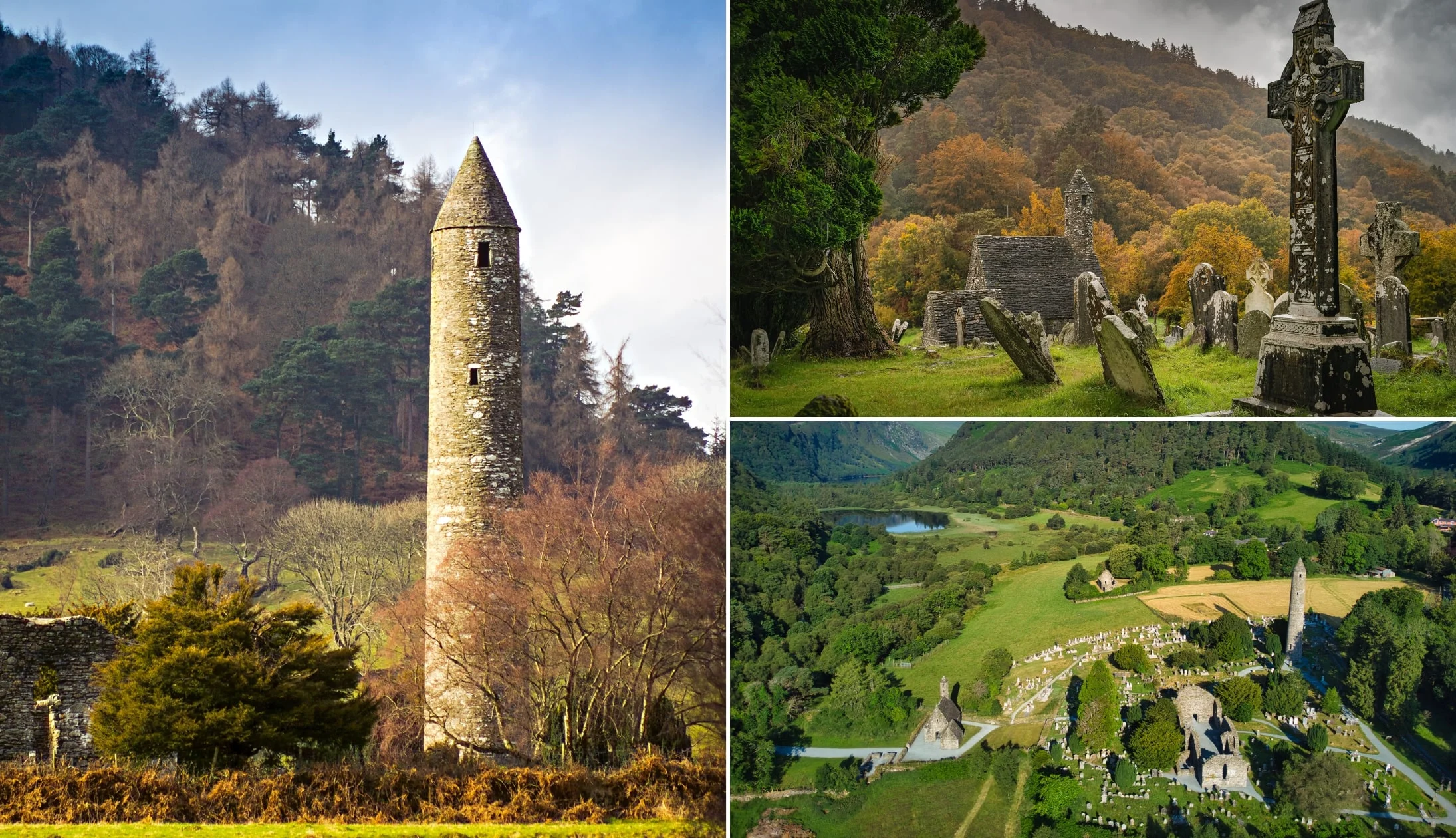We often get emails asking why do we celebrate St. Patrick’s Day in Ireland and elsewhere.
For some, it’s to celebrate Irish heritage or to give a nod to St. Patrick himself, Ireland’s Patron Saint.
For others, it’s an excuse to have a drink with friends while throwing on some green garments.
But where did it all begin? In this guide, we’ll tell you about the origin of St. Patrick’s Day and how March 17th is marked in Ireland and around the world.
Some quick need-to-knows about St. Patrick’s Day

Before you scroll down to ready about the St. Patrick’s Day history, read the points below – they’ll get you up-to-speed quickly:
1. When is St. Patrick’s Day 2024?
Although St. Patrick’s Day takes place on the same date each year, March 17th, the day of the week varies. St. Patrick’s Day 2024 is on Sunday, March 17th.
2. What it celebrates
March 17th, 461 is said to be the date of St. Patrick’s death. It is on this day that the world celebrates Ireland’s Patron Saint and his extraordinary life.
3. How it is celebrated
There are many St. Patrick’s Day traditions including public parades, traditional Irish music sessions and wearing of green attire. On the whole, March 17th is a celebration of both St. Patrick and Irish culture.
4. Where the day originated
The origin of St. Patrick’s Day, the ‘Feast of St. Patrick’ or Lá Fhéile Pádraig in Irish, goes back over 1,000 years, though it’s only in the last couple of centuries that the parades we know today truly started taking place.
St. Patrick’s Day history and background

Where St. Patrick is believed to be buried (via Shutterstock)
We get asked why was St. Patrick’s Day created quite a bit, so we’ll go into detail without going over the top.
Below, you’ll get an insight into St. Patrick and where the celebrations all began. Dive on in!
St. Patrick’s early life

Photos via Shutterstock
Unsurprisingly enough, the St. Patrick’s Day history starts with the man himself. St. Patrick is the patron saint of Ireland, yet beyond a few tales of him bashing snakes (among other things), little is known of his life.
Patrick (his name was actually Maewyn Succat) was born in what was then Roman Britain into a wealthy family in the year 385.
However, his life was turned upside down at the age of 16 when raiders from Ireland captured him and took him across the Irish Sea to live in servitude as a shepherd, possibly somewhere in County Mayo.
His discovery of religion

Photos via Shutterstock
It was also during this time period that he discovered religion. Six years later, he received a message in a dream and somehow managed to escape back to Britain.
It was then that he began 15 years of religious training where he was ordained into the priesthood.
Here, he experienced another dream telling him to go back to Ireland to spread the word of Christianity. And that’s exactly what he did!
His life in Ireland

Photos via Shutterstock
He landed in Ireland in either 432 or 433 somewhere on the Wicklow coast, and went on to found many Christian communities throughout Ireland.
He also established the church in Armagh that became the ecclesiastical capital of the churches of Ireland.
As this guide is more focused on how and what does St. Patrick’s Day celebrate, we won’t go into more detail about his life in Ireland – you can read more about his past in our St. Patrick guide.
The first St. Patrick’s Day

Photos via Shutterstock
The next part of the St. Patrick’s Day history is the origin of the celebration. In the centuries following St. Patrick’s death in Downpatrick (believed to have been March 17th, 461), the mythology surrounding his life became ever more ingrained in the Irish culture.
Since around the ninth or 10th century, people in Ireland have been observing the Roman Catholic feast day of St. Patrick on March 17th.
These days 1000 years ago would have looked nothing like our grandiose celebrations today and the truth is that we don’t really know when the first proper St. Patrick’s Day was.
In fact, you probably wouldn’t even have called them ‘celebrations’, as they would have been more like simple religious services.
Yet despite the reverence in Ireland shown towards the great man, it was actually thousands of miles away across an ocean that the first St. Patrick’s Day was recorded!
Early parades in the Americas

Photos via Shutterstock
Records show that a St. Patrick’s Day parade was held on March 17, 1601 in a Spanish colony in what is now St. Augustine, Florida.
The parade, and a St. Patrick’s Day celebration a year earlier were apparently organised by the Spanish colony’s Irish vicar Ricardo Artur.
Over a century later, The Charitable Irish Society of Boston organised the first observance of Saint Patrick’s Day in the Thirteen Colonies (the name for the USA before the Revolutionary War) in 1737.
To this day, Boston remains a very Irish city, although interestingly the celebrations were particularly not Catholic in nature, as Irish immigration to the colonies had been dominated by Protestants in this time period.
Thirty-five years later homesick Irish soldiers serving in the English military marched in New York City on March 17th 1772 to honour the Irish patron saint.
In 1848, multiple New York Irish Aid societies decided to unite their parades with the idea of forming one official New York City St. Patrick’s Day Parade. Today, that parade is the world‘s oldest civilian parade and the biggest St. Patrick’s Day parade in the United States, with over 150,000 participants.
The first Irish celebrations

Photos via Shutterstock
As for St. Patrick’s (adopted) home country, in 1903 St. Patrick’s Day became an official public holiday in Ireland and the first St. Patrick’s Day parade there was held in Waterford in that same year.
For most of the next 30 years, the day was a somewhat muted affair, with Ireland going through political upheaval including a civil war and the traumatic partition of its borders.
The first official, state-sponsored St. Patrick’s Day parade in Dublin took place in 1931, although north of the border it was a little more tense over the years, especially during The Troubles (late 1960s–late 1990s).
Though happily since 1996, there has been a greater emphasis on celebrating a fluid and inclusive notion of ‘Irishness’, rather than an identity based around traditional religious or ethnic allegiance.
The National St. Patrick’s Day Parade in Dublin is now one of the largest in the world!
St. Patrick’s Day around the world

Where St. Patrick is believed to be buried (via Shutterstock)
Now that we have the St. Patrick’s Day history out of the way, it’s time to see how the rest of the world celebrates.
Speaking of the world, St. Patrick’s Day is now a global event. From Chicago famously colouring its river green on March 17th to jaunty street parades in far-flung cities like Tokyo and Sydney.
Huge celebrations also take place in the land of St. Patrick’s birth, particularly in British cities like Liverpool and Birmingham which contain many residents with Irish ancestry who are more than happy to embrace their heritage.
Paddy’s Day is even celebrated in space! Canadian astronaut Chris Hadfield famously took photographs of Ireland from Earth orbit in 2013 and also pictured himself wearing green clothes on March 17th.
FAQs about the origin of St. Patrick’s Day
We’ve had a lot of questions over the years asking about everything from ‘When is St, Patrick’s Day?’ to ‘Why do we celebrate St. Patrick’s Day?’.
In the section below, we’ve popped in the most FAQs that we’ve received. If you have a question that we haven’t tackled, ask away in the comments section below. Here are some related reads you should find interesting:
- 73 Funny St. Patrick’s Day Jokes For Adults And Kids
- The Best Irish Songs And The Best Irish Films Of All Time For Paddy’s Day
- 8 Ways That We Celebrate St. Patrick’s Day In Ireland
- 17 Tasty St. Patrick’s Day Cocktails To Whip Up At Home
- How To Say Happy St. Patrick’s Day In Irish
- 5 St. Patrick’s Day Prayers And Blessings For 2023
- 17 Surprising Fact’s About St. Patrick’ Day
- 33 Interesting Facts About Ireland
Why do we celebrate St. Patrick’s Day?
The origin of St. Patrick’s Day was to mark the day of his passing and to celebrate the life of Ireland’s Patron Saint.
Is St. Patrick’s Day every March 17?
Yes, St. Patrick’s Day takes place on March 17th every year. While it’s a public holiday in Ireland, it isn’t anywhere else in the world.
Why is St. Patrick’s Day so big in Ireland?
It’s tradition. Do note, however, that many people don’t actively celebrate it and will use the day as any other day of annual leave.


Marianela Quinlan
Tuesday 25th of February 2020
Hi Keith, So happy I stumbled on your website. Just on a lunch break at work and need waaaaaaaaaaay more time to go through it, but I am planning a trip to Ireland March 2020. I'm thinking 10-14 days but have not landed on a solid plan. I will be there for my 50th birthday and by chance my birthday happens to fall on St. Patrick's Day. Even though I was born in Chile, now living in Canada the majority of my life, we do have Irish descendants on my dad's side. I have never been to Europe and I thought what better way to celebrate a "milestone". In any case, there will be some friends and family joining us, so far 9 people, not including myself and my husband. Pretty sure some will initially be with us just for the birthday celebration piece and then go and do their own thing (which is fine by me). In the end, I want to do what I want to do and don't want to worry if other people are in agreement or not. I love being outdoors, exploring, hiking etc, and can't wait to explore but just have no idea where to start, and if we should drive, etc...especially with the number of people who will initially start the trip with us. I will check out your site more when I get the chance but in the mean time, just saying 'hi', and can't wait to read and learn more!! Cheers!!